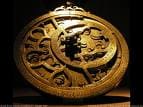The Astrolabe is an ancient instrument employed for measuring the angular position of Sun and stars, used also to project the celestial sphere on the plane of the equator.
The name "astrolabe" comes from the Latin singular "astrolabium", plural "astrolabia".
In turn, from the Greek. "Aster" means star. "Lambanein" means take, seize, catch, grasp, apprehend, determine, estimate. Taken together, an astrolabium is a star taker or star finder.

An astrolabe is an instrument for telling time by sighting the Sun or another known star. The astrolabe is a delightful, surprisingly precise instrument -- provides the time to within a few minutes, except near noon. The astrolabe had to be designed for a specific location and year. They were popular, in western Europe, during the Renaissance, as a status symbol. The wealthy could commission one to be custom-made.
A brief history and description of the Astrolabe:
The mariner's astrolabe was stripped of all frills. The outer circle of the disc was quartered by crossed lines representing the horizon and the zenith. Half of the upper hemisphere was graduated into 90 degrees. The alidade or vane was fitted with two sights and the instrument held aloft by a ring in the top while the observation was being made. It was not very satisfactory and there were many complaints.
Probably, the first astrolabium was constructed in 400 AD; but, possibly as early as 150 BC. The earliest surviving instrument is from c 0900 AD. The astrolabia were popular in Europe, including England, between 1100 and 1700.
Traditionally, they were made of brass. The astrolabium is a device for telling time, to within a few minutes, at any time -- day or night --, except near noon. It also may be employed to find true north, in the daytime, or at night, even when the polar star is obscured. The astrolabium may be employed to measure the height of a pole or tower. The astrolabium may be employed as a theodelitus, in surveying. It was only since 1775, with the availability of the marine chronometer, that the astrolabium could be employed for navigation; but, by that time, the astrolabium had fallen out of fashion.
By 1700, the significantly more precise sextant and theodelitus instruments displaced the astrolabium. However, these specialized instruments lacked the ability to perform the required calculations. Instead, one has to have books of tables of the trigonometric functions and ephemerides.